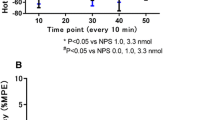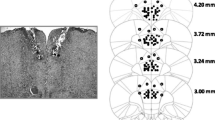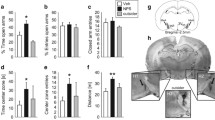Abstract
Effects of intracerebroventircular (ICV), neuropeptide Y (NPY) (0.2–5.0 nmol) and its C-terminal 13–36 amino acid (AA) fragment (0.4–2.0 nmol) have been examined with respect to anxiolytic properties in two rat anxiety models, Montgomery's conflict test (MT), and Vogel's drinking conflict test (VT). In the MT, 1.0 and 5.0 nmol NPY abolished the normal preference for the closed arms of the maze. At 5.0 nmol, the total number of entries made into both closed and open arms was decreased by 50%. In the VT, both 0.2 and 1.0 nmol NPY markedly increased the number of shocks accepted. The effect of 5.0 nmol NPY was less pronounced. In control experiments, NPY (0.2 nmol) did not affect pain sensitivity or thirst. Pretreatment with the selective alpha2-adrenergic receptor antagonist idazoxan, at a dose which by itself did not affect behaviour (2.0 mg/kg), antagonized the effect of 1.0 nmol NPY in the VT. NPY 13-36 was without significant effect in both models. The results suggest that NPY exerts anxiolytic-like effects, and that these effects are mediated through an interaction with noradrenergic systems. Higher doses of NPY produce sedation and ataxia, which decrease overall activity in the MT, and interfere with the ability fully to express behaviourally the anxiolytic-like effect in the VT. The findings are discussed in relation to the noradrenaline hypothesis of anxiety, and to observations indicating involvement of NPY in the pathophysiology of major depression.
Similar content being viewed by others
References
Adrian TE, Allen JM, Bloom SR, Ghatei MA, Rossor MN, Roberts GW, Crow TJ, Tatemoto K, Polak JM (1983) Neuropeptide Y distribution in human brain. Nature 306:584–586
Agnati LF, Fuxe K, Benfenati F, Battistini N, Härfstrand A, Tatemoto K, Hökfelt T, Mutt V (1983) Neuropeptide Y in vitro selectively increases the number of alpha2-adrenergic binding sites in membranes of the medulla oblongata of the rat. Acta Physiol Scand 118:293–295
Albers HE, Ferris CF, Leeman SE, Goldman BD (1984) Avian pancretic polypeptide phase shifts hamster circadian rhythms when microinjected into the suprachiasmatic region. Science 223:833–834
Dettmar PW, Lynn AG, Tulloch IF (1983) Neuropharmacological studies in rodents on the action of RX 781094, a new selective alpha-2-drenoceptor antagonist. Neuropharmacology 22: 729–737
Drew GM, Gower AJ, Marriott AS (1979) Alpha-2-adrenoceptors mediate clonidine-induced sedation in the rat. Br J Pharmacol 67:133–142
Engel JA, Hjorth S, Svensson K, Carlsson A, Liljequist S (1984) Anticonflict effect of the putative serotonine receptor agonist 8-hydroxy-2-(DI-n-propylamino)tetralin (8-OH-DPAT). Eur J Pharmacol 105:365–368
Everitt BJ, Hökfelt T, Terenius L, Tatemoto KMV, Goldstein M (1984) Differential co-existence of neuropeptide Y (NPY)-like immunoreactivity with catecholamines in the central nervous system of the rat. Neuroscience 11:443–462
Flood JF, Hernandez EN, Morely JE (1987) Modulation of memory processing by neuropeptide Y. Brain Res 421:280–290
Fuxe K, Agnati LF, Härfstrand A, Zini I, Tatemoto K, Pich EM, Hökfelt T, Mutt V, Terenius L (1983) Central administration of Neuropeptide Y induces hypotension, bradypnea and EEG synchronization in the rat. Acta Physiol Scand 118:189–192
Handley SL, Mithani S (1984) Effects of alpha-adrenoceptor agonists and antagonists in a maze-exploration model of ‘fear’-motivated behaviour. Naunyn-Schmiedeberg's Arch Pharmacol 327:1–5
Heilig M, Murison R (1987a) Intracerebroventricular neuropeptide Y suppresses open field and home cage activity in the rat. Regul Pept 19:221–231
Heilig M, Murison R (1987b) Intracerebroventricular neuropeptide Y protects against stress-induced gastric erosion in the rat. Eur J Pharmacol 137:127–129
Heilig M, Wahlestedt C, Ekman R, Widerlöv E (1988a) Antidepressant drugs increase the concentration of neuropeptide Y (NPY)-like immunoreactivity in the rat brain. Eur J Pharmacol 147:465–467
Heilig M, Wahlestedt C, Widerlöv E (1988b) Neuropeptide Y (NPY) induced activity suppression in the rat: evidence for NPY receptor heterogeneity and for interaction with alpha-adrenergic receptors. Eur J Pharmacol 157:205–213
Hoen-Saric R, Merchant AF, Keyser ML, Smith VK (1981) Effects of clonidine on anxiety disorders. Arch Gen Psychiatry 39:735–742
Holmberg G, Gershon S (1961) Autonomic and psychic effects of yohimbine hydrochloride. Psychopharmacologia 2:93–106
Kahn RJ, McNair DM, Lipman RS, Covi L, Rickels K, Downing R, Fisher S, Frankenthaler LM (1986) Imipramine and chlordiazepoxide in depressive and anxiety disorders. II. Efficacy in anxious outpatients. Arch Gen Psychiatry 43:79–85
Kalra SP, Crowley WR (1984) Norepinephrine-like effects of neuropeptide Y on LH release in the rat. Life Sci 33:1173–1176
Keim KL, Sigg EB (1977) Plasma corticosterone and brain catecholamins in stress: effects of psychotropic drugs. Pharmacol Biochem Behav 6:79–85
Levine AS, Morley JE (1984) Neuropeptide Y: a potent inducer of consummatory behaviour in rats. Peptides 5:1025–1029
Lundberg JM, Terenius L, Hökfelt T, Martling CR, Tatemoto K, Mutt V, Polak J, Bloom S, Goldstein M (1982) Neuropeptide Y (NPY)-like immunoreactivity in peripheral noradrenergic neurons and effects of NPY on sympathetic function. Acta Physiol Scand 116:477–480
Modigh K (1987) Antidepressant drugs in anxiety disorders. Acta Psychiatr Scand [Suppl 335] 76:51–71
Montgomery KC (1958) the relation between fear induced by novel stimulation and exploratory behaviour. J Comp Physiol Psychol 48:254–260
Pellow S, Chopin P, File SE, Briley M (1985) Validation of open: closed arm entries in an elevated plus-maze as a measure of anxiety in the rat. J Neurosci Methods 14:149–167
Redmond DE, Huang YH (1979) New evidence for a locus coeruleus-noripinephrine connection with anxiety. Life Sci 25:2149–2162
Shephard RA (1986) Neurotransmitters, anxiety and benzodiazepines: a behavioural review. Neurosci Biobehav Rev 10:449–461
Söderpalm B, Engel JA (1988) Biphasic effects of clonidine on conflict behaviour; involvement of different alpha-receptors. Pharmacol Biochem and Behav 30:471–477
Söderpalm B, Eriksson E, Engel JA (1988) Anticonflict and rotarod impairing effects of alprazolam and diazepam in rat after acute and subchronic administration. Prog Neuropsychopharmacol Biol Psychiatry 12 (in press)
Svensson TH, Bunney BS, Aghajanin GK (1975) Inhibition of both noradrenergic and serotonergic neurons in the brain by the alpha adrenergic agonist clonidine. Brain Res 92:291–306
Tatemoto K, Mutt V (1980) Isolation of two novel candidate hormones using a chemical method for finding naturally occurring polypeptides. Nature 285:417–418
Undén A, Tatemoto K, Mutt V, Bartfai T (1984) Neuropeptide Y receptor in the brain. Eur J Biochem 145:525–530
Vogel JR, Beer B, Clody DE (1971) A simple and reliable conflict procedure for testing anti-anxiety agents. Psychopharmacologia 21:1–7
Wahlestedt C, Yanaihara N, Håkanson R (1986) Evidence for different pre- and post-junctional receptors for neuropeptide Y and related peptides. Regul Pept 13:307–318
Wahlestedt C, Skagerberg G, Ekman R, Heilig M, Sundler F, Håkanson R (1987) Neuropeptide Y (NPY) in the area of the hypothalamic paraventricular nucleus activates the pituitary-adrenocortical axis in the rat. Brain Res 417:33–38
Wahlestedt C, Ekman R, Widerlöv E (1989) Neuropeptide Y (NPY) and the central nervous system: distribution, effects and possible relationship to neurological and psychiatric disorders. Prog Neuropsychopharmacol Biol Psychiatry (in press)
Westlin-Danielsson A, Undén A, Abens J, Andell S, Bartfai T (1987) Neuropeptide Y receptors and the inhibition of adenylate cyclase in the human frontal and temporal cortex. Neurosci Lett 74:237–242
Widerlöv E, Lindström LH, Wahlestedt C, Ekman R (1988) Neuropeptide Y and peptide YY as possible cerebrospinal fluid markers for major depression and schizophrenia, respectively. J Psychiatr Res 22 (1):68–79
Zini I, Pich EM, Fuxe K, Lenzi PL, Agnati LF, Härfstrand A, Mutt V, Tatemoto K, Moscara M (1984) Actions of centrally administered neuropeptide Y on EEG activity in different rat strains and in different phases of their circadian cycle. Acta Physiol Scand 122:71–77
Author information
Authors and Affiliations
Rights and permissions
About this article
Cite this article
Heilig, M., Söderpalm, B., Engel, J.A. et al. Centrally administered neuropeptide Y (NPY) produces anxiolytic-like effects in animal anxiety models. Psychopharmacology 98, 524–529 (1989). https://doi.org/10.1007/BF00441953
Received:
Accepted:
Issue Date:
DOI: https://doi.org/10.1007/BF00441953




